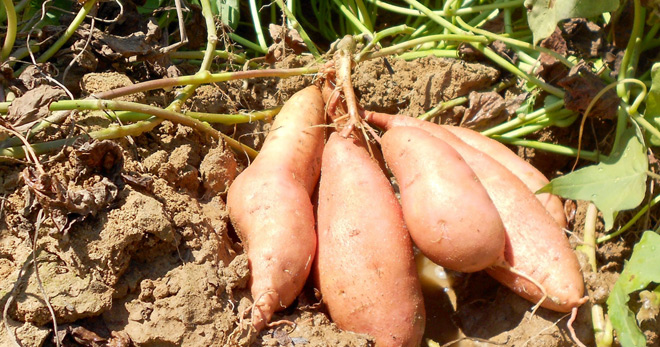
Sweet potatoes have a growing period of 3-6 months depending on the variety.
The Kenya Agricultural and Livestock Research Organization (KALRO) in collaboration with the International Potato Center have developed five promising sweet potato varieties for small scale farmers in Kenya. Under the national performance trials, the five varieties Kemb 10, Kemb 23, SPK 013, SPK 004 and Japanese 420009 pumpkin have shown outstanding yields beyond the local varieties currently grown.
Sweet potatoes are fairly easy to grow but very few Kenyan farmers realize the full potential of their sweet potato crop. This usually happens when the sweet potatoes are smaller in size and hence fetch a lower price in the market. Larger and bigger sweet potatoes always mean more money in farmers' pockets. The crop is rich in Vitamin A, and is very healthy. it is normally eaten as a breakfast meal by most families both urban and rural.
According to the research done by the research firm, the following is the guide to successful sweet potato production.
Adaptation
Sweet potatoes are adaptable to different agro ecological zones ranging from 0-2100m above sea level and occasionally are found in altitudes of about 2400m. They thrive at temperatures above 24°C in abundant sunshine. They require rainfall of 750-1000mm per annum and will need a moderate soil pH of 6.0 for optimum production.
They also require well drained, free soil to allow root development. Sweet potatoes have a growing period of 3-6 months depending on the variety. However in the short rains farmers prefer those maturing in 3 months and in the long rains those maturing in 6 months. Land should be prepared to loosen the soils to make mounds of 80x30cm and 1-3 vines planted per mound or on ridges of 90-1500m by 30-60cm along the ridges.
SEE ALSO: KALRO selling Mucinya' sweet potato that creeps 4X faster
Establishment
Vines are used for establishment. The shoot vines should be cut 30cm from the growing point before planting.
Cropping systems
Sweet potato can be relay cropped with maize i.e. when maize has reached physiological maturity, about one month to harvest, mounds/ridges can be made within the rows of maize at 30-60cm apart and the vines planted.
Diseases and pests
The potato mosaic disease caused by a virus is the most common sweet potato disease. It is controlled by using clean planting materials, resistant cultivars, removal and burning of infected plants in the field. In addition chemicals such as 0.1% Carbaryl, 0.1% Tenthion and 1% Hebtachlor can be used for disease control. The pests include sweet potato weevils that attack the tubers. The pest is managed by planting resistant varieties, earthing up, using deep rooting varieties, timely harvesting, crop rotation and proper storage.
SEE ALSO: Farmers make silage from sweet potato vines
Maturity, harvesting and storage
Sweet potatoes mature after 3-6 months depending on the varieties. Yellowing and drying of leaves is mostly an indication of maturity. Harvesting can be done by piece meal using sharpened sticks or metal rods or matches. Removal of all the tubers at once is also undertaken using hoes. Care should be taken to avoid damaging the tubers (wounding) during harvesting. Usually sweet potatoes are stored in the field although after harvesting the tuber should be used. Curing can also be done to promote healing of wounds inflicted during harvesting. Tubers are cured by subjecting them to temperatures of 27-29.5°C and relative humidity of 85-90% for 4-7 days and then storing them at 13-16°C and relative humidity of 85-90%. In rural areas, they can be stored in underground pit or platforms, covered with soil.
SEE ALSO: Ugandans’ scramble for orange fleshed sweet potatoes change farmers’ fortunes
Potential yields
In Kenya, fresh tuber yields can get to 13 tons per ha
Utilization
In Kenya, sweet potatoes are consumed by building, baking, frying or roasting the unprocessed tubers and vines. Tubers and vines are also fed to livestock. Vines can be ensiled. Industrially starch can be extracted from tubers.
Seed availability
High yielding vines (seed) can be obtained at KALRO RRC-Kisii which has a multiplication nursery. Framers in Kabondo, Ndhiwa have also started multiplying seed materials of the outstanding five varieties.
Market
Marketing of sweet potato tubers is very good in major producing areas like Kabondo, where some merchants come from as far as Mombasa, Nairobi and Nakuru. They contract the farmers and purchase their tubers at wholesale prices on the farm. There are also in other urban centers where sweet potatoes are used as substitute for bread.
















Comments powered by CComment